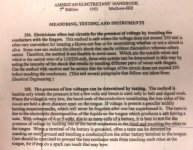I did a little bit more examination, yesterday. The three wire circuit terminates at two double outlets in a single wall box. Each has a different hot and they share a common neutral, delivering 115V at each outlet. The breaker box end is messed up. One hot is on one half of a "2-in-one" breaker, the other is on one half of a different "2-in-1" breaker. I think I should pull some breakers and swap some wires around and just not tell anybody that I did so.
You really should think about getting a qualified and licensed electrician to look at it, as this is what they do for a living. Paying an electrician to do it right will cost a bit, but for a business it is worth it from an insurance standpoint.
For multiwire branch circuits, the relevant paragraph that directly affects what you've just described is 2017 NEC Article 210.4(B) Disconnecting Means, which says, in part: "Each multiwire branch circuit shall be provided with a means that will simultaneously disconnect all ungrounded conductors at the point where the branch circuit originates...." Single-pole breakers may be used for this purpose as long as there is an 'identified' handle-tie between the two poles, as provided by 2017 NEC Article 240.15(B)(1). This type of circuit is illustrated in the 2017 NEC Handbook on page 63.
NEC uses very specific definitions of these terms:
1.)Shall. Means 'you
absolutely have to do this, no ifs, ands, or buts, do not pass Go, do not collect $200.'
2.)Ungrounded conductor. This is a currently-carrying circuit conductor that is not bonded to the grounding conductor and is typically what most people call a 'hot' conductor; there is a such thing as a 'grounded hot' in certain cases, such as corner-grounded 'neutral-less' delta three-phase (got one of those circuits at $dayjob).
3.)Grounded conductor. This is a conductor that is bonded to the grounding conductor at one point. Typical US single-phase two-pole power (120/240) has the neutral or transformer midpoint grounded at the service entrance by the ground bond to the grounding conductor, but there are several exceptions in industrial settings, especially once you graduate to medium-voltage stuff like some of the 2,400V stuff here at $dayjob.
4.)Grounding conductor. This is a conductor that is tied to earth ground via one or more bonded electrodes; the grounding conductor is not allowed to carry circuit operating current but only fault current.
5.) Identified (as applied to equipment). Recognizable as suitable for the specific purpose. This isn't as strict as 'listed' but, in the specific case of handle ties, a simple wire or pin pushed through the holes in the single-pole handles didn't satisfy one inspector I dealt with; she said that the handle tie had to be designed for that specific breaker or a recognized (by the Authority Having Jurisdiction or AHJ) 'compatible' breaker. That particular AHJ recognized several plugin breakers as being compatible; GE and Siemens, for instance, for a particular panel type could use the same handle ties, but they had to be actual 'handle ties' manufactured for the purpose. Maintenance had put a piece of 12AWG copper wire through the tie-hole with bends on each end, and that didn't pass. An 'identified' handle tie for GE THQL 1-inch breakers looks like
https://www.amazon.com/THT104-GE-CIRCUIT-BREAKERS-THT104CP/dp/B007937DDS/
Would you mind sharing a pic of that '2-in-1 breaker' you mentioned? I've seen some of these; four poles in a two-pole space, with the center two poles handle-tied and the outer two poles handle-tied. Is that what you see?

